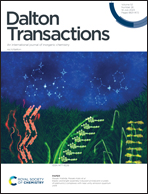Bilayered lanthanide squarate hydrates (Ln = Eu to Lu) and magnetization reversal barriers of 21 K for Ln = Tm and 57 K for Yb†
Abstract
A squarate (sq) bridge was applied to heavy lanthanide (Ln) complexes for possible development of high-performance single-ion magnets (SIMs). A selective synthetic method for lanthanide squarate hydrates [Ln2(sq)3(H2O)8]n (abbreviated as Ln-sq) has been established, where Ln stands for Eu, Gd, Tb, Dy, Ho, Er, Tm, Yb, and Lu. As the crystallographic analysis clarified, they all form a bilayer polymeric structure, which is isomorphic to known Eu-sq and Tb-sq. The coordination structures are described as an almost ideal square antiprism with D4d symmetry. Frequency-dependent susceptibility was recorded in alternating-current magnetic measurements for Ln = Tb, Dy, Er, Tm, and Yb. In particular, as for less studied Ln-based SIMs, the effective magnetization-reversal barriers, Ueff/kB = 21.4 ± 0.4 K (in a bias field of 1800 Oe) and 57.0 ± 0.4 K (400 Oe), were characterized for Tm-sq and Yb-sq, respectively, according to the Orbach-type relaxation mechanism plus a direct or the Raman mechanism. The barrier found for Yb-sq is the highest among those for all the compounds investigated here, and also regarded as one of the largest values for the Yb-based SIMs known so far. The complete-active-space self-consistent-field (CASSCF) calculation was applied to Tm- and Yb-sq. The ground doublet states with mJ = ±6 for the Tm3+ ion and mJ = ±7/2 for the Yb3+ ion were reproduced.



 Please wait while we load your content...
Please wait while we load your content...